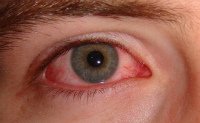What is Pink Eye?
Were your eyelids matted together in the morning when you awoke? Are your coworkers or fellow students telling you that your eyes look red? Do your eyes feel irritated with a burning sensation? You may have Pink Eye.
It is the most common
eye problem
presenting to eye doctor clinics. Because the condition is so contagious, you will be sent home to avoid infecting others.
In order to view the content, you must install the Adobe Flash Player. Please click
here to get started.
What are the symptoms of Pink Eye?
 Irritated eyes and watery discharge. Watery discharge is common with virus infections.Tendency for the eyelids to stick together during sleep is common with bacterial infections.One eye may be affected first, but within a day or two both eyes are involvedMucopurulent discharge develops (yellow discharge) in the case of bacterial infections.Small hemorrhages known as petechial hemorrhages may be seen on the conjunctiva (the transparent tissue covering the white part of the eye) in the case of acute infections. Acute infections may be caused by either bacteria or virus. In the case of bacterial infection, the tarsal conjunctiva (the tissue lining the inside of the eyelids in direct contact with the eyeball) usually features a papillary response. Papillae are collections of white blood cells (lymphocytes and plasma cells).
Irritated eyes and watery discharge. Watery discharge is common with virus infections.Tendency for the eyelids to stick together during sleep is common with bacterial infections.One eye may be affected first, but within a day or two both eyes are involvedMucopurulent discharge develops (yellow discharge) in the case of bacterial infections.Small hemorrhages known as petechial hemorrhages may be seen on the conjunctiva (the transparent tissue covering the white part of the eye) in the case of acute infections. Acute infections may be caused by either bacteria or virus. In the case of bacterial infection, the tarsal conjunctiva (the tissue lining the inside of the eyelids in direct contact with the eyeball) usually features a papillary response. Papillae are collections of white blood cells (lymphocytes and plasma cells). They are best viewed by your eye doctor by flipping your eyelids and viewing their surface under the slit lamp. The slit lamp is like a “microscope” to help view small structures under magnification.
In the case of viral infection, the tarsal conjunctiva usually features a follicular formation of the conjunctiva. Follicles are smooth elevations of the conjunctiva indicating a lymphocytic response. Vessels surround the raised follicle. These “bumps” are typically found in the lower inner conjunctiva as shown below.
How will your Pink Eye be treated?
This condition will typically respond to antibiotic
eye drops
or ointment used for a seven-day course when the infection is bacterial.
When Haemophilus influenza is the cause of the infection, Augmentin (amoxicillin/clavulanate 20 to 40 mg/kg/day in three doses) should be used because of the other possible nonocular complications like ear infection or pneumonia. Make sure to use warm compresses to loosen the crusting of your matted lids in the morning.
Pink Eye is highly contagious, whether it is caused by bacteria or virus. Make sure to change your pillow cases daily to avoid re-infection as well as towels.
Never use the same tissue for both eyes. Once you have used a tissue to pat your eye, throw it away and do not reuse it. The discharge from your eyes can keep the infection active or infect someone else. Also, wash your hands frequently.
You can think of a viral infection as a “cold” in the eye. Just like you would not be given antibiotics for a cold (unless you had strep throat), your eye doctor will not give you antibiotic eye drops for viral conjunctivitis unless there is evidence of secondary bacterial infection.
Treatment for viral eye infections is primarily supportive. Your eye doctor will recommend cold compresses to reduce the swelling of the eyelids and lubricating drops to soothe the eyes.
Just like you would use decongestants to help you feel better from a cold, you may use a decongestant eye drop temporarily for the redness.
Return from Pink Eye to Eye diseases
Enjoy this page? Please pay it forward. Here's how...
Would you prefer to share this page with others by linking to it?
- Click on the HTML link code below.
- Copy and paste it, adding a note of your own, into your blog, a Web page, forums, a blog comment,
your Facebook account, or anywhere that someone would find this page valuable.





